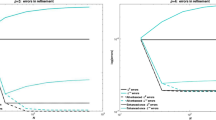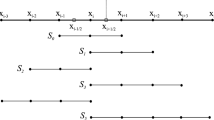Abstract
Adaptive mesh refinement (AMR) and wavelet-based multi-resolution technique, which refine the spatial resolution in regions of interest and coarsen the mesh in other regions, are widely used in scientific computing for higher computational efficiency. The key component of AMR and the multi-resolution method is the adaptation strategy including the regularity estimation. In this paper, a new adaptation strategy for AMR and the multi-resolution method is proposed. Different from AMR, which measures the function regularity based on an empirical gradient operator, and the multi-resolution method with complicated wavelet analysis, the new approach examines the solution smoothness based on the high-order TENO reconstruction (Fu et al. in J Comput Phys 305:333–359, 2016). The core idea is that the TENO scheme not only provides the reconstructed data at the cell interface for flux evaluation but also classifies the local flow scales as smooth or nonsmooth on the discretized mesh. Since the scale-separation procedure is achieved in the spectral and characteristic space, the new adaptation strategy is weakly problem-dependent. Moreover, the extra complexity due to the empirical gradient computing or the wavelet analysis is eliminated. Based on Harten’s finite-volume multi-resolution method (Harten in J Comput Phys 115(2):319–338, 1994), a set of benchmark cases is simulated to validate the performance of the proposed method.





















Similar content being viewed by others
Data Availability
The data that support the findings of this study are available from the corresponding author upon reasonable request.
References
Fu, L., Karp, M., Bose, S.T., Moin, P., Urzay, J.: Shock-induced heating and transition to turbulence in a hypersonic boundary layer. J. Fluid Mech. 909, A8 (2021)
Fu, L., Hu, X.Y., Adams, N.A.: Single-step reinitialization and extending algorithms for level-set based multi-phase flow simulations. Comput. Phys. Commun. 221, 63–80 (2017)
Berger, M.J., Oliger, J.: Adaptive mesh refinement for hyperbolic partial differential equations. J. Comput. Phys. 53(3), 484–512 (1984)
Berger, M.J., Colella, P.: Local adaptive mesh refinement for shock hydrodynamics. J. Comput. Phys. 82(1), 64–84 (1989)
Domingues, M.O., Gomes, S.M., Roussel, O., Schneider, K.: Space-time adaptive multiresolution methods for hyperbolic conservation laws: applications to compressible Euler equations. Appl. Numer. Math. 59(9), 2303–2321 (2009)
Reckinger, S.J., Livescu, D., Vasilyev, O.V.: Comprehensive numerical methodology for direct numerical simulations of compressible Rayleigh–Taylor instability. J. Comput. Phys. 313, 181–208 (2016)
Hatori, T., Ito, A.M., Nunami, M., Usui, H., Miura, H.: Level-by-level artificial viscosity and visualization for MHD simulation with adaptive mesh refinement. J. Comput. Phys. 319, 231–241 (2016)
Donat, R., Martí, M.C., Martínez-Gavara, A., Mulet, P.: Well-balanced adaptive mesh refinement for shallow water flows. J. Comput. Phys. 257, 937–953 (2014)
Berger, M.J., George, D.L., LeVeque, R.J., Mandli, K.T.: The GeoClaw software for depth-averaged flows with adaptive refinement. Adv. Water Resour. 34(9), 1195–1206 (2011)
Liu, C., Hu, C.: Adaptive THINC-GFM for compressible multi-medium flows. J. Comput. Phys. 342, 43–65 (2017)
Han, L.H., Hu, X.Y., Adams, N.A.: Adaptive multi-resolution method for compressible multi-phase flows with sharp interface model and pyramid data structure. J. Comput. Phys. 262, 131–152 (2014)
Baeza, A., Mulet, P.: Adaptive mesh refinement techniques for high-order shock capturing schemes for multi-dimensional hydrodynamic simulations. Int. J. Numer. Meth. Fluids 52(4), 455–471 (2006)
Dumbser, M., Zanotti, O., Hidalgo, A., Balsara, D.S.: ADER-WENO finite volume schemes with space-time adaptive mesh refinement. J. Comput. Phys. 248, 257–286 (2013)
Zanotti, O., Fambri, F., Dumbser, M., Hidalgo, A.: Space-time adaptive ADER discontinuous Galerkin finite element schemes with a posteriori sub-cell finite volume limiting. Comput. Fluids 118, 204–224 (2015)
Semplice, M., Coco, A., Russo, G.: Adaptive mesh refinement for hyperbolic systems based on third-order compact WENO reconstruction. J. Sci. Comput. 66(2), 692–724 (2016)
Tang, Q., Chacon, L., Kolev, T.V., Shadid, J.N., Tang, X.-Z.: An adaptive scalable fully implicit algorithm based on stabilized finite element for reduced visco-resistive MHD. J. Comput. Phys. 454, 110967 (2022)
Bell, J., Almgren, A., Beckner, V., Day, M., Lijewski, M., Nonaka, A., Zhang, W.: BoxLib user’s guide.https://github.com/BoxLib-Codes/BoxLib (2012)
Hornung, R.D., Kohn, S.R.: Managing application complexity in the SAMRAI object-oriented framework. Concurr. Comput. Pract. Exp. 14(5), 347–368 (2002)
Colella, P., Graves, D., Ligocki, T., Martin, D., Modiano, D., Serafini, D., Van Straalen, B.: Chombo software package for AMR applications design document (2000)
MacNeice, P., Olson, K.M., Mobarry, C., De Fainchtein, R., Packer, C.: PARAMESH: a parallel adaptive mesh refinement community toolkit. Comput. Phys. Commun. 126(3), 330–354 (2000)
de la Asunción, M., Castro, M.: Simulation of tsunamis generated by landslides using adaptive mesh refinement on GPU. J. Comput. Phys. 345, 91–110 (2017)
Fu, L., Hu, X.Y., Adams, N.A.: A physics-motivated Centroidal Voronoi Particle domain decomposition method. J. Comput. Phys. 335, 718–735 (2017)
Deiterding, R., Domingues, M.O., Gomes, S.M., Schneider, K.: Comparison of adaptive multiresolution and adaptive mesh refinement applied to simulations of the compressible Euler equations. SIAM J. Sci. Comput. 38(5), S173–S193 (2016)
Vasilyev, O.V., Bowman, C.: Second-generation wavelet collocation method for the solution of partial differential equations. J. Comput. Phys. 165(2), 660–693 (2000)
Benkiewicz, K., Hayashi, K.: Two-dimensional numerical simulations of multi-headed detonations in oxygen-aluminum mixtures using an adaptive mesh refinement. Shock Waves 12(5), 385–402 (2003)
Harten, A.: Adaptive multiresolution schemes for shock computations. J. Comput. Phys. 115(2), 319–338 (1994)
Bihari, B.L., Harten, A.: Multiresolution schemes for the numerical solution of 2-D conservation laws I. SIAM J. Sci. Comput. 18(2), 315–354 (1997)
Dumbser, M., Hidalgo, A., Zanotti, O.: High order space-time adaptive ADER-WENO finite volume schemes for non-conservative hyperbolic systems. Comput. Methods Appl. Mech. Eng. 268, 359–387 (2014)
Fambri, F., Dumbser, M., Zanotti, O.: Space-time adaptive ADER-DG schemes for dissipative flows: compressible Navier–Stokes and resistive MHD equations. Comput. Phys. Commun. 220, 297–318 (2017)
Fu, L., Hu, X.Y., Adams, N.A.: A family of high-order targeted ENO schemes for compressible-fluid simulations. J. Comput. Phys. 305, 333–359 (2016)
Fu, L., Hu, X.Y., Adams, N.A.: Targeted ENO schemes with tailored resolution property for hyperbolic conservation laws. J. Comput. Phys. 349, 97–121 (2017)
Fu, L., Hu, X.Y., Adams, N.A.: A new class of adaptive high-order targeted ENO schemes for hyperbolic conservation laws. J. Comput. Phys. 374, 724–751 (2018)
Fu, L.: A low-dissipation finite-volume method based on a new TENO shock-capturing scheme. Comput. Phys. Commun. 235, 25–39 (2019)
Fu, L.: A very-high-order TENO scheme for all-speed gas dynamics and turbulence. Comput. Phys. Commun. 244, 117–131 (2019)
Fu, L.: A Hybrid Method with TENO Based Discontinuity Indicator for Hyperbolic Conservation Laws. Commun. Comput. Phys. 26, 973–1007 (2019)
Li, Y., Fu, L., Adams, N.A.: A low-dissipation shock-capturing framework with flexible nonlinear dissipation control. J. Comput. Phys. 428, 109960 (2021)
Ji, Z., Liang, T., Fu, L.: A class of new high-order finite-volume TENO schemes for hyperbolic conservation laws with unstructured meshes. J. Sci. Comput. 92(2), 61 (2022)
Pirozzoli, S.: On the spectral properties of shock-capturing schemes. J. Comput. Phys. 219(2), 489–497 (2006)
Fu, L., Hu, X.Y., Adams, N.A.: A family of high order targeted ENO schemes for compressible fluid simulations. In: The Ninth Symposium on Turbulence and Shear Flow Phenomena (TSFP-9), June 30–July 3 (2015)
Haimovich, O., Frankel, S.H.: Numerical simulations of compressible multicomponent and multiphase flow using a high-order targeted ENO (TENO) finite-volume method. Comput. Fluids 146, 105–116 (2017)
Sun, Z., Inaba, S., Xiao, F.: Boundary Variation Diminishing (BVD) reconstruction: a new approach to improve Godunov schemes. J. Comput. Phys. 322, 309–325 (2016)
Jiang, G.S., Shu, C.-W.: Efficient implementation of weighted ENO schemes. J. Comput. Phys. 126(1), 202–228 (1996)
Borges, R., Carmona, M., Costa, B., Don, W.S.: An improved weighted essentially non-oscillatory scheme for hyperbolic conservation laws. J. Comput. Phys. 227, 3191–3211 (2008)
Fu, L., Hu, X.Y., Adams, N.A.: Implicit large eddy simulations with a high-order TENO scheme. In: Tenth International Symposium on Turbulence and Shear Flow Phenomena (TSFP10), July 6–9, 2017 (2017)
Fu, L., Hu, X.Y., Adams, N.A.: A new class of adaptive high-order TENO schemes for Hyperbolic Conservation Laws. In: ECCOMAS Thematic Conference: European Conference on High Order Nonlinear Numerical Methods for Evolutionary PDEs: Theory and Applications, March 27–31, 2017 (2017)
Fu, L., Hu, X.Y., Adams, N.A.: A targeted ENO scheme as implicit model for turbulent and genuine subgrid scales. Commun. Comput. Phys. 26(2), 311–345 (2019)
Ren, Y.-X., Liu, M., Zhang, H.: A characteristic-wise hybrid compact-WENO scheme for solving hyperbolic conservation laws. J. Comput. Phys. 192(2), 365–386 (2003)
Domingues, M.O., Gomes, S.M., Roussel, O., Schneider, K.: An adaptive multiresolution scheme with local time stepping for evolutionary PDEs. J. Comput. Phys. 227, 3758–3780 (2008)
Gottlieb, S., Shu, C.-W., Tadmor, E.: Strong stability-preserving high-order time discretization methods. SIAM Rev. 43(1), 89–112 (2001)
Toro, E.F., Spruce, M., Speares, W.: Restoration of the contact surface in the HLL-Riemann solver. Shock Waves 4(1), 25–34 (1994)
Zhang, R., Zhang, M., Shu, C.-W.: On the order of accuracy and numerical performance of two classes of finite volume WENO schemes. Commun. Comput. Phys. 9(03), 807–827 (2011)
Sun, Z., Teng, H., Xiao, F.: A slope constrained 4th order multi-moment finite volume method with weno limiter. Commun. Comput. Phys. 18(4), 901–930 (2015)
Sod, G.A.: A survey of several finite difference methods for systems of nonlinear hyperbolic conservation laws. J. Comput. Phys. 27, 1–31 (1978)
Gaburro, E., Dumbser, M.: A posteriori subcell finite volume limiter for general \( P_NP_M \) PNPM schemes: applications from gasdynamics to relativistic magnetohydrodynamics. J. Sci. Comput. 86(3), 1–41 (2021)
Takagi, S., Fu, L., Wakimura, H., Xiao, F.: A novel high-order low-dissipation TENO-THINC scheme for hyperbolic conservation laws. J. Comput. Phys. 452, 110899 (2022)
Woodward, P.: The numerical simulation of two-dimensional fluid flow with strong shocks. J. Comput. Phys. 54, 115–173 (1984)
Shu, C.W., Osher, S.: Efficient implementation of essentially non-oscillatory shock-capturing schemes, II. J. Comput. Phys. 83, 32–78 (1989)
Xu, Z., Shu, C.W.: Anti-diffusive flux corrections for high order finite difference WENO schemes. J. Comput. Phys. 205, 458–485 (2005)
Lax, P.D., Liu, X.-D.: Solution of two-dimensional Riemann problems of gas dynamics by positive schemes. SIAM J. Sci. Comput. 19(2), 319–340 (1998)
Kurganov, A., Tadmor, E.: Solution of two-dimensional Riemann problems for gas dynamics without Riemann problem solvers. Numer. Methods Partial Differ. Equ. 18(5), 584–608 (2002)
Jung, C.-Y., Nguyen, T.B.: Fine structures for the solutions of the two-dimensional Riemann problems by high-order WENO schemes. Adv. Comput. Math. 44, 147–174 (2018)
Jung, C.-Y., Nguyen, T.B.: Fine structures for the solutions of the two-dimensional Riemann problems by high-order WENO schemes. Adv. Comput. Math. 44(1), 147–174 (2018)
Shen, Y., Zha, G.: Generalized finite compact difference scheme for shock/complex flowfield interaction. J. Comput. Phys. 230(12), 4419–4436 (2011)
Liska, R., Wendroff, B.: Comparison of several difference schemes on 1D and 2D test problems for the Euler equations. SIAM J. Sci. Comput. 25(3), 995–1017 (2003)
Vandenbroucke, B., De Rijcke, S.: The moving mesh code Shadowfax. Astron. Comput. 16, 109–130 (2016)
Funding
Lin Fu acknowledges the fund from Guangdong Basic and Applied Basic Research Foundation (No. 2022A1515011779), the fund from Shenzhen Municipal Central Government Guides Local Science and Technology Development Special Funds Funded Projects (No. 2021Szvup138), and the fund from Key Laboratory of Computational Aerodynamics, AVIC Aerodynamics Research Institute.
Author information
Authors and Affiliations
Corresponding author
Ethics declarations
Conflict of interest
The authors declare that they have no known competing financial interests or personal relationships that could have appeared to influence the work reported in this paper.
Additional information
Publisher's Note
Springer Nature remains neutral with regard to jurisdictional claims in published maps and institutional affiliations.
Rights and permissions
Springer Nature or its licensor holds exclusive rights to this article under a publishing agreement with the author(s) or other rightsholder(s); author self-archiving of the accepted manuscript version of this article is solely governed by the terms of such publishing agreement and applicable law.
About this article
Cite this article
Fu, L., Liang, T. A New Adaptation Strategy for Multi-resolution Method. J Sci Comput 93, 43 (2022). https://doi.org/10.1007/s10915-022-02012-5
Received:
Revised:
Accepted:
Published:
DOI: https://doi.org/10.1007/s10915-022-02012-5




